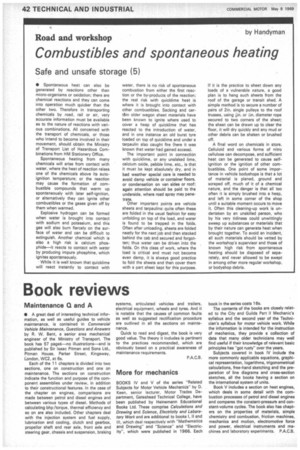Road and workshop by Handyman
Page 44

If you've noticed an error in this article please click here to report it so we can fix it.
Combustibles and spontaneous heating
Safe and unsafe storage (5)
• Spontaneous heat can also be generated by reactions other than micro-organisms or oxidation; there are chemical reactions and they can come into operation much quicker than the other two. Therefore in transporting chemicals by road, rail or air, very accurate information must be available as to the nature of reactions with vahous combinations, All concerned with the transport of chemicals, or those who intend to become involved in their movement, should obtain the Ministry of Transport List of Hazardous Combinations from HM Stationery Office.
Spontaneous heating from many chemicals will arise from contact with water, where the heat of reaction raises one of the chemicals above its autoignition temperature; or the reaction may cause the formation of combustible compounds that warm up spontaneously with later self-ignition, or alternatively they can ignite other combustibles or the gases given off by them when warmed.
Explosive hydrogen can be formed when water is brought into contact with sodium and potassium, and this gas will also burn fiercely on the surface of water and can be difficult to extinguish. Another chemical which is also a high risk is calcium phosphide—it reacts to contact with water by producing impure phosphine, which ignites spontaneously.
While it is well known that quicklime will react instantly to contact with water, there is no risk of spontaneous combustion from either the first reaction or the by-products of the reaction; the real risk with quicklime heat is where it is brought into contact with other combustibles. Sacking and certhin older wagon sheet materials have been known to ignite where used to cover a heap of quicklime that has reacted to the introduction of water, and in one instance an old burst tyre loaded on top of quicklime and under a tarpaulin also caught fire (here it was known that water had gained access).
The important point in connection with quicklime, or any unslaked lime, calcium oxide, pebble lime, etc., is that it must be kept absolutely dry, and in bad weather special .care is needed to avoid damp vehicle or container floors. or condensation on van sides or roof: again attention should be paid to the underside, where road spray may penetrate.
Other important points are vehicle sheets and tarpaulins: quite often these are folded in the usual fashion for easy unfolding on top of the load, and water is found to be trapped in the folds. Often after unloading, sheets are folded neatly for the next lob and then stacked behind the cab and secured and forgotten; thus water can be driven into the folds. On this class of work, where the load is critical and must not become even damp, it is always good practice to fold the sheets and then cover them with a part sheet kept for this purpose. If it is the practice to sheet down any loads of a vulnerable nature, a good plan is to hang such sheets from the roof of the garage or transit shed. A simple method is to secure a number of pairs of 2in. single pulleys to the roof trusses, using n. or ;in. diameter rope secured to two corners of the sheet; the sheet can be drawn up to clear the floor, it will dry quickly and any mud or other debris can be shaken or brushed off.
A final word on chemicals in store. Celluloid and various forms of nitro cellulose can decompose, and sufficient heat can be generated to cause selfignition or the ignition of other combustibles. One point of some importance in vehicle bodyshops is that a lot of material is planed, ground and scraped off, much of it of a chemical nature, and the danger is that all too often it is simply brushed into a heap, and left in some corner of the shop until a suitable moment occurs to move it. Often this cleaning-up work is undertaken by an unskilled person, who by his very tidiness could unwittingly sweep up substances or materials that by their nature can generate heat when brought together. To avoid an incident, all such materials should be vetted by the workshop's supervisor and those of known high risk from spontaneous heating should be disposed of separately, and never allowed to be swept in among other more regular workshop, or bodyshop debris.


















































































































